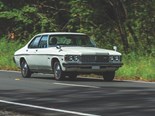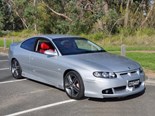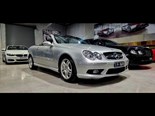Ferrari Dino Review
 Ferrari Dino
Ferrari Dino

 Ferrari Dino
Ferrari Dino

 Ferrari Dino
Ferrari Dino

 Ferrari Dino
Ferrari Dino

 Ferrari Dino
Ferrari Dino


|
|
Ferrari Dino
|

|
|
Ferrari Dino
|

|
|
Ferrari Dino
|

|
|
Ferrari Dino
|

|
|
Ferrari Dino
|
Even for a Ferrari, this is an exceptional car... We take a look at the famous Dino.

|
|
Ferrari Dino
|
Ferrari Dino
Hailed in its day as one of the greatest sports cars of all time, the Dino 246GT still offers a driving experience few cars can match...
Many companies launch cars with great claims and high hope, but so rarely is a car released that captures the spirit of the moment and maintains its stature for generations to come.
One such car is the littlest Ferrari, the Dino 246. The shape, the mechanical layout, the price – and above all, the way it drove – captured the very essence of sports motoring.
Ferrari had long been a dominating force in racing and sports car design, manufacture and marketing, the name becoming a household word by the 1960s. But times were a-changing and Enzo Ferrari, along with his many cohorts, understood there was demand for sports cars other than large, front-engined V12 machines.
Ferrari and his engineers had long looked at smaller models – the ASA 1000GT of the early ’60s being the closest anyone had seen. This pretty four-cylinder design ended up being manufactured by another company after Enzo got cold feet.
The time when Ferrari was working on new small car concepts coincided with a period when styling house Pininfarina was at its zenith, creating smoothly curved, voluptuous shapes. Their design work became an important part of the process that Ferrari would follow. Pininfarina showed a V6 mid-engined, three-seater styling exercise at the 1965 Paris Salon – the 206S – from which the styling of the eventual production car would evolve.
A new engineering feature was gaining ground, which the new small sports car would incorporate – a transversely-mounted mid-engine. While Ferrari had built the 250LM competition car as their first mid-engined car (1963-66), it used their venerable 3.3-litre V12, which was mounted north-south behind the cockpit, in the same manner as most mid-engined cars.
Interestingly, across town Lamborghini was also working on a transverse mid-engine design, the V12 Miura, which would see the light of day in 1966.
Working closely with Pininfarina, Ferrari’s engineers developed the new small car to incorporate a 1987cc 65-degree V6 engine. With quad cams and triple Weber carburettors, the aluminium alloy engine was an absolute jewel. A new five-speed gearbox was developed, along with many other specially-designed major components for the all-new car.
Launched at the Turin motor show in 1967, the new car was an immediate hit. The name Ferrari chose for the car was Dino, the name of his son who had died in 1956 from leukaemia at the age of 24. In fact, Enzo thought there was some risk to the Ferrari image involved with the new small car project, and the name Ferrari did not appear on the car. While designed, built and sold alongside traditional Ferraris, Enzo was cautious to distance the new Dino from his larger cars.
That said, from day one, just about every owner fitted Ferrari badges to their Dinos. Even dealers did it.
The Dino 206 was so right for the time that it became an instant success. The media hailed the new sports car as one of the greatest of all time – quite likely unaware that it would be perceived as such many decades later.
Well respected racing driver and journalist Paul Frere was among the first to drive the car saying it was "a revelation… perfectly neutral and incredibly agile." British magazine Car tested a Dino in 1970 and enthused about the driving characteristics: "Driving the Dino is quite an experience, for it is probably closer to a mid-engined racing car than to most road vehicles.
It has that instant responsiveness and ‘chuckability’ that the French so delightfully term ‘nerveuse’, which makes it a joy on twisting roads." They summed it up by saying the Dino "probably has the best handling of any high performance GT car".
The car was quite a performer. Developing 135kW at 8000rpm, it could accelerate to 100km/h in 7.6sec and achieve a top speed of 240km/h. The handling was a revelation: pin-sharp steering, strong brakes, very little body-roll and excellent adhesion made the Dino one of the best handling cars of the time.
The Dino’s styling is among the all-time greats. Curvaceous and so very sexy, the design features a cut-off Kamm-tail and a long, low rear deck, allowing good rear three-quarter vision (something lacking in many early mid-engined cars). It was a very balanced shape, with a wide stance and many lovely details, such as the side air intakes and delicate chrome trim.
Production got underway in 1968, with Scaglietti assembling the alloy-bodied cars and in the following year, major changes were made to the Dino. After only 152 cars had been built, Ferrari announced the Dino 246GT.
As the name suggests (2.4-litre, six-cylinder), the engine capacity was enlarged. But significantly, the new engine also changed to a cast iron block. The 2419cc engine offered increased power and torque, giving the new version a 0-100km/h time 0.5sec quicker and an additional 12km/h top speed. The engine’s increased torque suited the Dino well, making it an even better driver’s car.
Alongside the engine modifications, Ferrari saw fit to make several other changes. Material for the bodies was changed to steel. The centre of the body was extended by 580mm, and detail changes such as a fuel filler flap were incorporated. The off-centre gear-selector tunnel was centred so that right-hand drive cars could be built.
These changes coincided with an agreement with Fiat, which saw the huge conglomerate take Dino engines for their own cars. Fiat introduced the Fiat Dino Coupe (with Bertone body) and Dino Spider (by Pininfarina), both initially with the 2.0-litre V6, and Lancia used the Dino engine for their dramatic and seriously effective Stratos rally car.
For the first time ever, Ferrari enjoyed the economy of scale benefits that come from the relatively mass manufacture of an engine.
Ferrari offered a couple of variations on the 246 theme. There were several options available on the 246, one of the best known being the ‘Chairs & Flares’ option, which consisted of seats upholstered in the Daytona style ventilated trim, along with flared wheelarches to accommodate a wider wheel and tyre package.
More significant though was the GTS version, introduced in 1972. This adaptation incorporated a removable centre section of the roof. The GTS also differed by having three small vents (matching those on the bonnet) replace the coupe’s rear side windows. This open-topped version proved very popular.
The Dino became Ferrari’s greatest-yet success. It introduced a whole new range of clientele to the brand and when production ceased in 1974, more than 3700 246s had been made, making it far and away the company’s best seller.
The Dino sold in an interesting marketplace, where its natural enemy was the Porsche 911 – still a relatively new car at the time. By comparison, in 1972 a 246GT listed in Australia at $16,000, a 911S 2.4 was $15,628 and a Jaguar E Type V12 was just $11,929. Pricey though it was, the Dino cost half as much as a V12 Ferrari.
Dino values commonly dipped as low as $15,000 in the late 1970s, before reaching sky-high figures in the boom at the end of the following decade. Amounts as high as $200,000 were achieved by some lucky sellers. Today, prices have settled in the $100,000-150,000 range, dependent on condition and history.
Dinos are prone to rust and were often poorly looked after by early owners. A few local cars were also imported second-hand from the UK. Hence, the vast majority of Dinos in Australia today have been restored at least once.
And that’s part of the history of the immaculate yellow 246GT featured here. Current owner John Trettel bought the 1972-built car from Melbourne several years ago. It had been the subject of a comprehensive restoration some years before, but after a while John decided he wanted his Dino perfect. The bodywork, interior, engine, gearbox, suspension, brakes, steering, chromework – everything has been rebuilt or replaced with new parts.
John even managed to locate some correct 1970s-type Michelin XWX tyres. No expense was spared – and it has certainly been an expensive exercise. The second restoration was completed almost a year ago, and the car is quite probably better than it was when new.
John had owned a couple of new Ferraris, but had always been attracted by the classic Dino.
"When I was living in Italy in about 1974, I nearly bought one, but for reasons of practicality I bought a Fiat Dino Coupe," John explained.
Many years later he realised his dream. He initially found the Dino a more demanding car to drive than his then-current Ferrari 360 Spider.
"Even after completely rebuilding the gearbox, you still have to wait for it to warm up; just skip second gear for a while."
However, that demanding characteristic grows on you. The Dino insists that you become involved in the driving process – beginning with a slightly un-natural driving position, with the pedals offset to the centre. Then there’s the warming up process; both the engine and gearbox like quite a few kilometres before they are friendly.
But once you and the Dino are ready to play, a harmony develops with the car that is reassuring, confidence inspiring and quite exciting. The Dino is one of those rare cars where you really feel it is a part of you. The controls respond instantaneously, accurately and inspiringly.
Before your first drive, you might imagine the 2.4-litre car’s strength to be handling, not performance. When you have got the feel of the Dino and explore what it has to offer, perhaps the greatest surprise is the engine’s performance. A buried accelerator brings out a wonderful howl from behind the cockpit, accompanied by impressive acceleration. Combine that with brilliant – almost intuitive – steering and handling, and the Dino makes exceptional progress.
Click the gearstick through that famous Ferrari alloy gate, gently ease the wood-rimmed steering wheel, and feel the thrum of the V6 just behind your shoulders – the Dino offers a unique and entirely pleasurable driving experience. And one that certainly lives up to the expectations that such an iconic car creates.
It is a pleasure to explore the Dino’s offerings on the confines of a race track, or on open country roads. And unlike some large supercars, it isn’t unwieldy around town. The Dino does, however, attract attention like few other cars.
The shape, the name, the aura, the classic, exotic icon status of the Dino all add up to make it one of the true greats – quite justly recognised as such.
*****
More reviews:
> Barn Find: Ferrari Dino review here
Search used:
>> Search Ferrari cars for sale
Unique Cars magazine Value Guides
Sell your car for free right here
Get your monthly fix of news, reviews and stories on the greatest cars and minds in the automotive world.
Subscribe

.jpg)














